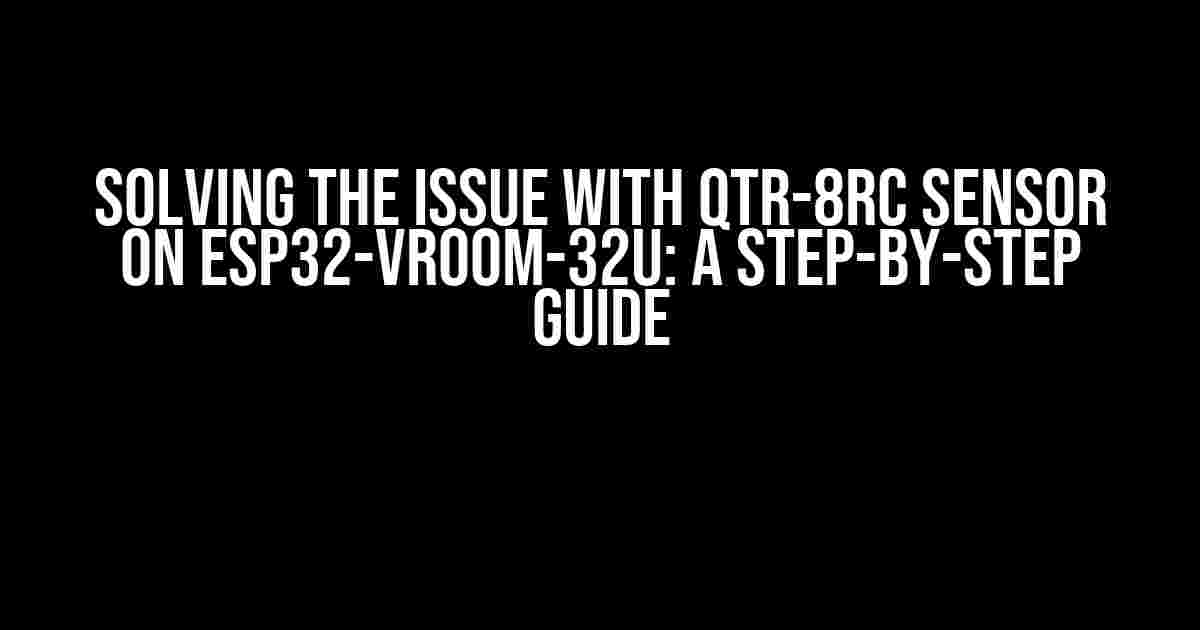Are you struggling to get your QTR-8RC sensor to work with your ESP32-VROOM-32U board? You’re not alone! Many makers and developers have encountered issues with this sensor, but don’t worry, we’ve got you covered. In this article, we’ll dive into the common problems and provide a comprehensive guide to troubleshooting and resolving the issue.
Understanding the QTR-8RC Sensor
The QTR-8RC sensor is a reflective sensor array that detects objects and tracks their movement. It’s a popular choice for robotics, automation, and IoT projects. The sensor consists of eight IR LED emitters and receivers, which work together to detect reflective objects.
Why the QTR-8RC Sensor Fails to Work with ESP32-VROOM-32U
Several reasons can cause the QTR-8RC sensor to malfunction with the ESP32-VROOM-32U board. Here are some common issues:
- Incompatible voltage levels: The QTR-8RC sensor operates at 5V, while the ESP32-VROOM-32U board operates at 3.3V.
- Insufficient power supply: The sensor requires a considerable amount of power, which the ESP32-VROOM-32U board might not be able to provide.
- Misconfigured pin connections: Incorrectly connected pins can lead to sensor malfunction.
- Software issues: Incorrect or outdated library versions, as well as coding mistakes, can prevent the sensor from working correctly.
Step-by-Step Troubleshooting Guide
Follow these steps to troubleshoot and resolve the issue with your QTR-8RC sensor on the ESP32-VROOM-32U board:
Step 1: Check the Power Supply
Ensure that the ESP32-VROOM-32U board is capable of providing enough power to the QTR-8RC sensor. You can do this by:
- Using an external power source for the sensor.
- Verifying that the board’s voltage regulator can handle the sensor’s power requirements.
voltage_regulator_capacity = 3.3V * 500mA = 1650mW
Compare this value to the sensor’s power requirements:
sensor_power_requirement = 5V * 50mA = 250mW
If the voltage regulator’s capacity is lower than the sensor’s power requirement, consider using an external power source.
Step 2: Verify Pin Connections
Double-check the pin connections between the QTR-8RC sensor and the ESP32-VROOM-32U board. Ensure that:
- VCC is connected to the board’s 5V pin.
- GND is connected to the board’s GND pin.
- Data pins (D0-D7) are connected to digital pins on the board (e.g., GPIO 18-25).
+---------------+---------------+ | QTR-8RC Pin | ESP32-VROOM-32U Pin | +---------------+---------------+ | VCC | 5V | | GND | GND | | D0 | GPIO 18 | | D1 | GPIO 19 | | ... | ... | | D7 | GPIO 25 | +---------------+---------------+
Step 3: Update the Library and Firmware
Ensure that you’re using the latest version of the QTR-8RC library and the ESP32-VROOM-32U board’s firmware. You can do this by:
- Checking the library’s GitHub repository for updates.
- Upgrading the board’s firmware using the manufacturer’s instructions.
git clone https://github.com/pololu/qtr-sensors-arduino.git
Update the library by running:
git pull origin master
Step 4: Modify the Code
Review your code to ensure that it’s correctly configured for the QTR-8RC sensor and the ESP32-VROOM-32U board. Check for:
- Correct pin assignments.
- Proper initialization and calibration of the sensor.
- Correct data reading and processing.
Here’s an example code snippet to get you started:
#include <QTRSensors.h>
#define NUM_SENSORS 8
#define TIMEOUT 2500
QTRSensors qtr[NUM_SENSORS];
void setup() {
Serial.begin(115200);
qtr.init(QTR_NO_EMITTERS_IN_USE, NUM_SENSORS, TIMEOUT, QTR_EMITTERS_ON, QTR_USE_EMITTERS);
}
void loop() {
uint16_t sensor_values[NUM_SENSORS];
qtr.read(sensor_values);
// Process the sensor readings
for (int i = 0; i < NUM_SENSORS; i++) {
Serial.print(sensor_values[i]);
Serial.print(" ");
}
Serial.println();
delay(50);
}
Step 5: Test the Sensor
Upload the modified code to your ESP32-VROOM-32U board and test the QTR-8RC sensor. Observe the sensor’s readings and verify that it’s working correctly.
| Sensor Reading | Expected Result |
|---|---|
| High values (above 500) | Object detected |
| Low values (below 200) | No object detected |
Conclusion
By following these steps, you should be able to troubleshoot and resolve the issue with your QTR-8RC sensor on the ESP32-VROOM-32U board. Remember to verify the power supply, pin connections, and library versions, and to modify the code to suit your specific project requirements. If you’re still experiencing issues, refer to the sensor’s datasheet and the board’s documentation for further assistance.
Happy making!
Frequently Asked Question
If you’re experiencing issues with the QTR-8RC sensor on your ESP32-VROOM-32U, you’re in the right place! Below, we’ve got the answers to the most pressing questions.
Why is my QTR-8RC sensor not working on my ESP32-VROOM-32U?
Make sure you’ve connected the sensor correctly! Double-check the VCC pin is connected to 3.3V, GND to GND, and the SIG pin to an analog input pin on your ESP32-VROOM-32U. If you’re still having trouble, try switching to a different analog input pin or checking for any hardware damage.
What is the correct way to initialize the QTR-8RC sensor on the ESP32-VROOM-32U?
To initialize the QTR-8RC sensor, you need to define the sensor pin as an analog input in your code. For example, if you’ve connected the SIG pin to pin 32, use `analogRead(32)` to read the sensor values. Then, use a library like PololuQTR to calibrate and read the sensor values.
Can I use multiple QTR-8RC sensors on my ESP32-VROOM-32U?
Yes, you can use multiple QTR-8RC sensors on your ESP32-VROOM-32U! However, keep in mind that each sensor requires a separate analog input pin. Make sure you have enough available pins and adjust your code accordingly to read values from each sensor.
Why are my QTR-8RC sensor readings fluctuating or inconsistent?
Inconsistent readings can be caused by electromagnetic interference (EMI), sensor misalignment, or even dirty sensors! Try moving away from sources of EMI, re-aligning the sensors, or cleaning the sensors with a soft brush and some water. If the issue persists, consider using a sensor with a longer range or a different sensor type.
How can I improve the accuracy of my QTR-8RC sensor readings on the ESP32-VROOM-32U?
To improve accuracy, try calibrating your sensor using a library like PololuQTR, which can help you determine the optimal threshold values for your specific environment. You can also try taking multiple readings and averaging them to reduce noise and increase precision.
